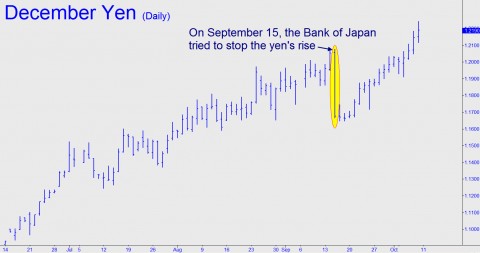Take a look at the graph below if you think the central banks have things under control. The chart shows the yen’s relentless rise since summer, punctuated by a single, nasty plunge on September 15. That was the day the Bank of Japan intervened in the currency markets for the first time in six years, prompted by concerns that the yen’s steep rise would hurt Japan’s export-based economy, and by the fact that the yen had recently spiked to a 15-year high versus the dollar. The intervention obviously failed, since the yen quickly recouped the loss and is now trading significantly higher than before the intervention. Because we have heard little from the Japanese since, however, we can only infer that they know enough to shut up rather than pretend they can bully speculators. Repeat a threat often enough, and eventually you become a laughing stock.
If Japan has thrown everything but the kitchen sink at the yen with no success, one can only imagine what it’s going to be like when it’s the Fed’s turn to “manage” the U.S. dollar. So far, the dollar has managed itself, albeit with plenty of help from central banks around the world that are even more keen on beating down their respective currencies than the U.S. is the dollar. But this is just small potatoes, a warm-up before the fat lady sings. Japan’s efforts to push down the yen have been geared toward padding the profits of its domestic manufacturers, and the scope of these efforts has therefore been commensurate in size with actual trade in physical goods. But the sums involved pale in comparison to the nearly quadrillion-dollar shell game that the world’s financiers have created with dollar-denominated securities. Don’t even think about trying to push that market around when it discovers it’s got a mind of its own.
1000-Year Tide
Of course, America’s won’t be trying to push the dollar down, but to keep it from collapsing. This hasn’t been a concern until now because the U.S. policy on the dollar has been to simply let it ease lower, much as it has been, and notwithstanding Geithner’s occasional, hollow assertions that the U.S. favors a” strong” dollar. There are signs, however, that the dollar’s more or less controlled drift lower could accelerate without warning and turn into a global rout. One is the relentless rise of gold and silver prices. Another is that China, with $2.3 trillion of reserves, has become an aggressive seller of U.S. Treasurys. Japan, as well as U.S. dealers glutted with easy money, have picked up some of the slack, but increasingly it is the Federal Reserve that has been buying the debt that foreigners no longer want. If you need further convincing that the dollar’s cachet has diminished around the world, consider that even the Russians, who for decades craved dollars on the black market, now shun the greenback, favoring rubles to play in one of the hottest asset markets in the world.
It should have been obvious all along that it would ultimately be the collapse of the dollar — the 50,000-pound gorilla of the global financial system — that would end the illusion that the central banks are all-powerful. One of these days this will become all-too-clear, for the bankers will be going up against a millennial tide of fiat money.
(If you’d like to have Rick’s Picks commentary delivered free each day to your e-mail box, click here.)


I don’t think there is any question that the first of the major currencies to “go to money heaven” will be the Japanese Yen.
The counter-intuitive Yen appreciation we are now witnessing is in fact that currency’s “death rattle”. The Japanese are now unwinding a multitude of carry trades in order to repatriate and liquidate their foreign investments. After 13 years of ZIRP, they are now being forced to consume their seed corn. This is how the end game will play out for all the major currencies and it is totally consistent with Rick’s thesis. A slow deflation accompanied by an excruciating currency appreciation, followed by a lightning-fast currency and bond market collapse resulting in a hyperinflation.